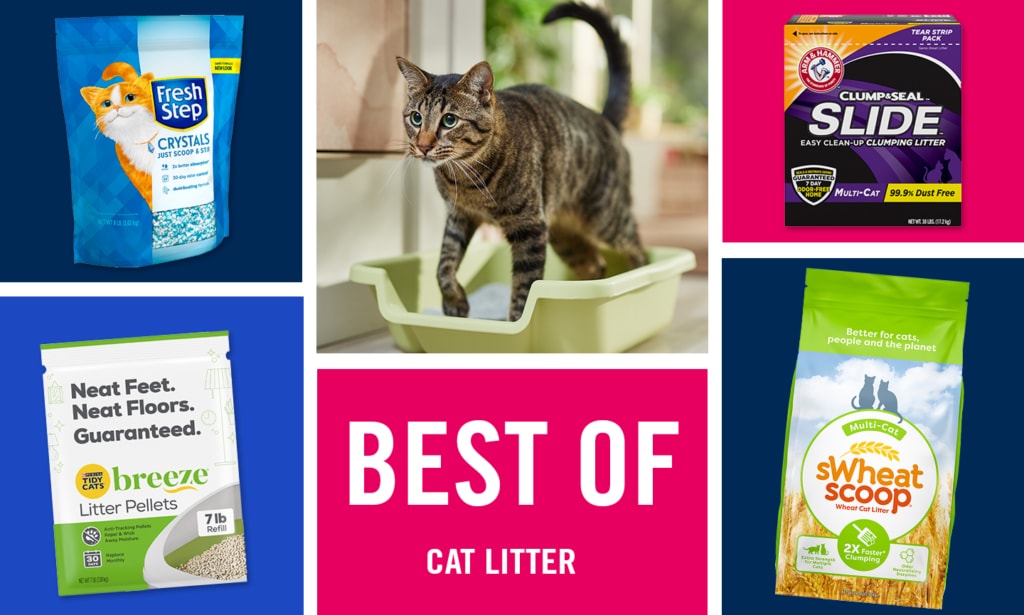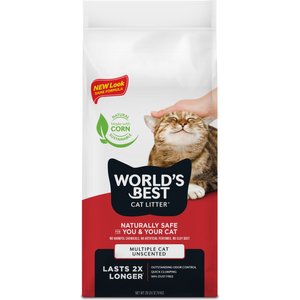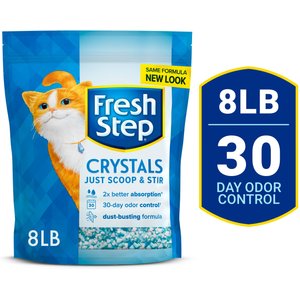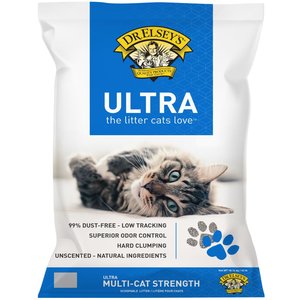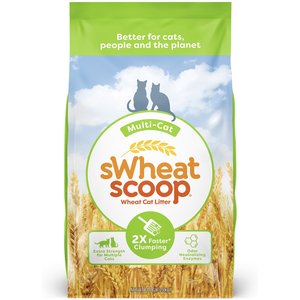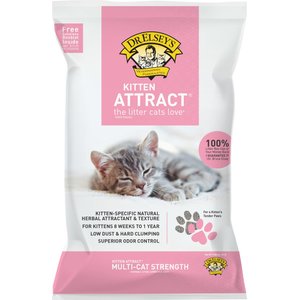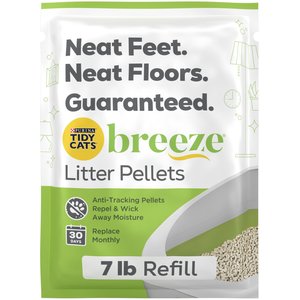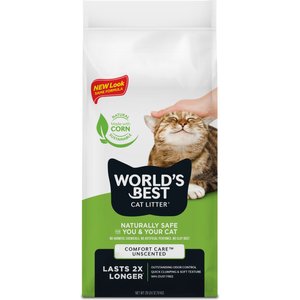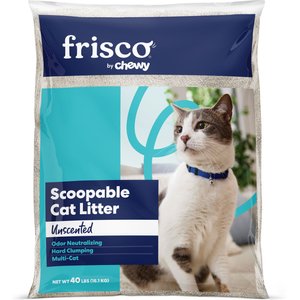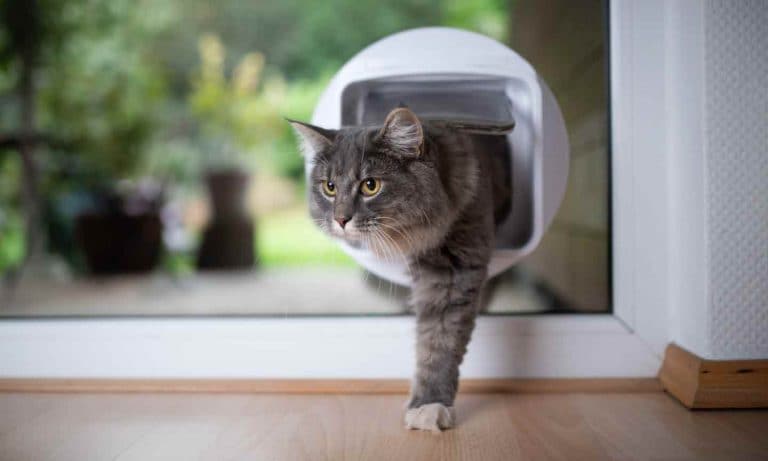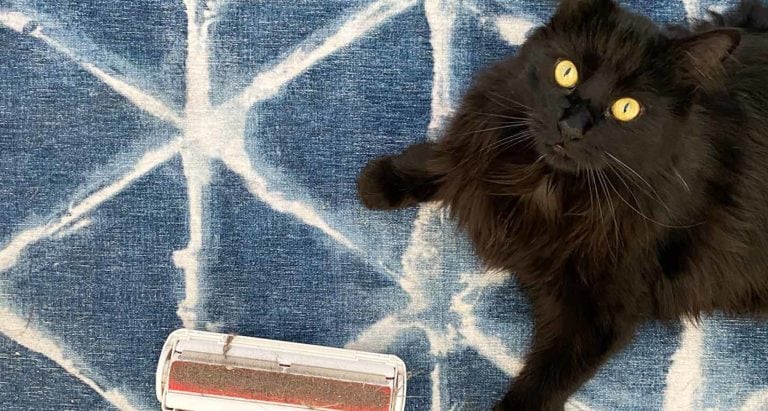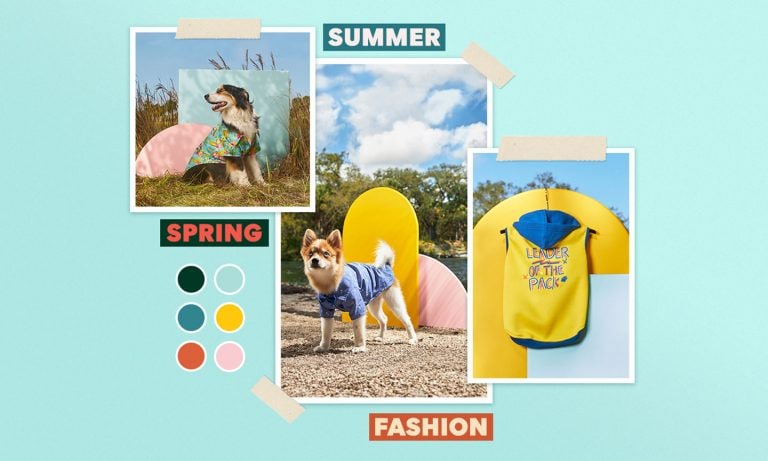As every cat parent knows, cleaning the litter box is one of the least rewarding aspects of the job. However, the right cat litter for your and your pet’s needs can make all the difference.
There are a wide range of litters available today, each offering unique benefits to cats and cat parents. Which one you choose can impact how easy it is to keep your space clean, your home smelling fresh and your cat happy.
Bathroom business is serious business, so there’s quite a bit to consider before selecting a litter. Read on for everything you need to know about the best cat litter on the market today, including expert tips and product picks from pet parents like you.
-
1
Best Cat Litter OverallWorld's Best Multi-Cat Unscented Clumping Corn Cat Litter, 28-lb bag $34 on Chewy
-
2
Best Cat Litter for Odor ControlFresh Step Premium Crystals Scented Non-Clumping Crystal Cat Litter, 8-lb bag $21 on Chewy
-
3
Best Clumping Cat LitterDr. Elsey's Ultra Multi-Cat Clumping Clay Cat Litter, 40-lb bag $21 on Chewy
-
4
Best Dust-Free Cat LitterArm & Hammer Slide Multi-Cat Clumping Clay Cat Litter, 38-lb box $27 on Chewy
-
5
Best Flushable Cat LittersWheat Scoop Multi-Cat Natural Clumping Wheat Cat Litter, 14-lb bag $17 on Chewy
How to Find the Best Cat Litter
At first glance, the amount of cat litters available today can be overwhelming. Where to start? First, consider these important factors:
- Materials: Cat litter is made from a variety of materials—from clay to silica gel to corn—with each offering its own benefits and drawbacks (more on that below).
- Clumping vs. non-clumping: To clump or not to clump, that is the age-old question. While there is no correct answer here, many cats (and cat parents) have strong preferences.
- Your litter box: If you have an automatic litter box, it’s important to use the type of litter suggested by the manufacturer. Many automatic litter boxes can use standard clumping litters, while others require specific litters.
- Your number of pets: If multiple cats will be using the litter, you might consider a multi-cat formula, which has additional odor neutralizers.
- Your cat’s health: If your cat has certain health conditions, your veterinarian may advise you to use specific litters. For example, cats with respiratory issues may benefit from low-dust litters. Some even change color to indicate potential health problems.
- Your lifestyle: Are you able to transport a heavy clay litter, or do you need a more lightweight option? Is non-tracking litter (litter that doesn’t stick to your cat and travel out of the box with them) important to you? How sensitive are you to fragrance or lack of fragrance? While your cat’s preferences are important, your litter also needs to work for your household.
- Your disposable method: How do you plan to dispose of litter? If you plan to scoop and flush, it’s important to use a flushable variety that’s safe for your plumbing.
- Your veterinarian’s advice: Using the litter box is an important part of your cat’s day, so consult your veterinarian before making changes to your litter, and ask for trusted product recommendations.
10 Best Cat Litters
To help you choose, we’ve rounded up the best cat litters as tested and approved by Chewy customers. These top-selling, top-rated cat litter brands get two paws up from cat parents like you.
Best Cat Litter Overall
-
No more kitty sneezing and coughing
We tried the different types of litter (clay, crystals, wood shavings, and such), powders, additives, air purifiers, and immediate cleaning after each use. The World’s Best litter was what stopped the sneezing and coughing. Back to the normal two to four-ish cleaning per day of the litter box. Product is fantastic, clumps the wet making sifting simple. Truly an outstanding litter product.
-
Absorbent , unscented, easy clean
This is the cat litter i depend on. Reduces odors to almost eliminated. Easy scoop, natural no chemicals . Cat preferred
-
Less tracking
This litter is great and there is less tracking. I mix it with a light weight litter just because my cat is transitioning but will eventually use this litter only.
Best Cat Litter for Odor Control
-
User Friendly
Cat and I both like it’s absorbing ability and easy on him and me. It’s very neat and easy to clean.
-
No odor and easy to clean up
He loves this special litter because it doesn’t stick to his feet and swipes off easily on his pad underneath his box.
-
Awesome
I use this in my PetSafe litter box and I can't say enough great things about it. It does everything it says it's going to. Controls odor, you only have to clean the box at least every 28 days, except that you do have to clean the poo out of the box at the end of the litter box but I highly recommend this litter!
Best Clumping Cat Litter
-
Best litter
This litter is amazing and for the price you cannot beat it if you compare to other brands, it is a better product all the way around and you get more for your money. Don’t be fooled by other options.
-
Love this stuff
I have switched back and forth on this litter. Always come back. On a fixed income, it's a value for me.
-
The Best
Dust and odor free. Little ends up outside the litter box. It’s economical because you don’t use a lot.
Best Dust-Free Cat Litter
-
I have finally found our litter!
Finally, a litter that we all like. All three use it and it's so easy to scoop and the litter tray stays clean
-
Cat Litter
I have tried just about every litter on the market, and arm and hammer clump and slide is the best. I have 5 cats and it works amazingly!
-
The Best in my Opinion.
Switched to this a year ago and will never buy anything else. Great at clumping, little if any dust, and no tracking!
Best Flushable Cat Litter
-
Nice bag but
I wish the bag was biodegradable, which is why I love this litter. It’s a bit dusty coming out of the bag, & tracks everywhere (but not as bad as the clay based litters) but I love that it’s biodegradable. I feel good about dumping it in the burn pile or the trash can (in a biodegradable bag) and I think it smells good. My girls had no trouble making the transition. If you’re on the fence, get it!
-
Our fave cat litter! Highly recommend it!
This is our fave cat litter brand and type. We like that there is no odor and low dust. Easy to use. Great at clumping and covering odor. We buy it regularly along with Fresh Step unscented. Only con is during summer months this litter tends to get infested with bugs before arrival. Fortunately, not since we've been buying from Chewy have we had this problem with bugs. Also, don't like how the bag size shrunk from 26lbs to now 28lbs and price went up too. Another case of shrink flation.
-
On the pricier side but worth it
Clumps well, no dust, reduces odor ( but doesn't eliminate it) No deodorizer added which is a good thing for our cats.
Best Litter for Kittens
-
shipping cat litter with other items
I didn't say anything when this arrived because I was able to use most of my litter but one of the two bags I ordered tore during shipping and litter got all over the interior of the shipping box and inside the two cases of can food I had ordered at the same time. Fortunately I discovered this outside so the inside of the house did n't get messed up and I was able to recover most of the expensive litter by pulling out the cans and shaking the litter out of them. This is the first time this has happened - I have had issues in the past with litter crushing cans which Chewy was very receptive about making restitution on. It was just...
-
My cat's love for this stuff
We moved to a new house and litter issues ensued. After multiple failed attempts at positioning, locations, number of litters to choose from (first one then 2 then 3!!! all for one cat!) ...It wasn't until we switched our actual litter to this one that she finally always 100% of the time used her litter. She is, fussy and 11 years old. This pleased our lady - thank you!
-
Made for kittens
I rescued a tiny kitten and got this litter because it said it was for kittens. She seems to like it - also I prefer a clumping litter.
Best Non-Tracking Cat Litter
-
Quick Delivery
I live in an area where we cannot always get the items we need for our pets. Chewy has it all and the quick delevery is the best!
-
Happy Mama - happy cat
I am enjoying the fact that my fur friend does not have litter stuck to her feet. She never had to adapt to the pellets - went directly from clumping litter to this.
Best Natural Cat Litter
-
BEST LITTER EVER
I've tried so many litters, and this one lives up to its name! It prevents anything from sticking to the bottom of the litter pan.
-
Sister uses this brand
It works well and is safe to use when you have other animals in the house that will eat the poop.
-
Same old formula
I wasn’t sure where to turn when they changed the formula. I’ve used their product for many years happily
Best for Multiple Cat Households
-
We love the fresh step
We’ve been using this every since it came out. It is great to use keeps the smell at bay encourages our five cats to use their liver pans often sorry no photo.
-
Stays fresh!
We have to keep one of our cats in the bedroom because he is naughty. Consequently, I need the litter to stay fresh and not have dust. This is what this cat litter does.
-
It works!
In a time when so many products promise so much...and let you down...this stuff actually DOES WHAT IT SAYS. Controls odor from two cats!
Best Budget Cat Litter
-
I love it!
No scent, low dust and well priced. What more could I ask for ? I'm going to test it against the $30 Whisker litter.
-
Uncented, yea!
Uncented and low dust are important to me. My cat uses the litter with easy. Not much gets stuck to his paws. We clean the box daily and have no odors. There is some dust. It is manageable.
-
Litter is Best When In the Bag
I’m a little bit tired of getting these shipments with slow leak holes in the bags. The box always has 2 cups or more of liter sliding around in the box. Makes a huge mess. DO BETTER!!
Types of Cat Litter
Cat litters are available in a wide range of materials and offer a number of features. Here, Joey Lusvardi, CCBC, a Minneapolis-based certified cat behavior consultant and founder of Class Act Cats, helps us break it down.
Clay
The most common types of cat litters are made from clay—specifically bentonite clay, which is highly absorbent, although other types of clay may be present depending on the type of litter. Clay litters can be clumping or non-clumping, and with a consistency reminiscent of sand or dirt, offer an alluring, natural texture.
“For most cats, a basic unscented clay clumping litter will work great, as it is easy to scoop; controls odor well if you scoop regularly; and it meets the preferences of most cats,” says Lusvardi.
Best for: most cats without special litter needs; budget-conscious pet parents
Silica Gel
Also known as crystal litter, silica gel litter is a mineral-based litter made from silica gel granules. The lightweight granules trap odors and absorb urine without clumping, and produce minimal dust. Some brands, such as PrettyLitter, change colors to help monitor the cat’s urine content.
While many cats happily use crystal litter, others may not like the texture. “Crystal litter tends to have sharp edges, and may not be very comfortable for cats to walk on,” Lusvardi says.
Best for: pet parents who prefer a lighter litter; cats with respiratory and urinary health concerns; households concerned about litter dust and tracking
Natural
Natural cat litters are made from sustainable, biodegradable materials including paper, corn, tofu, cedar, walnuts and grass. Natural litters rely on their fiber-heavy compositions to absorb urine.
Because natural cat litter is made with renewable materials, it’s one of the most eco-friendly options you can choose, says Lusvardi. “I often recommend clients try a grass litter if they are thinking of switching to a natural litter. It has qualities that are pretty close to a typical clay litter but is less dusty.”
Best for: ingredient-conscious and environmentally friendly pet parents; cats who do not like the texture of more traditional litters; cats who are sensitive to chemicals and fragrances
Multi-Cat
Multi-cat litters typically contain extra odor neutralizers and fragrances, making them effective at keeping households with multiple pets smelling fresh. Multi-cat litters can be made from a variety of materials, and many cats tolerate them. However, if your cat is sensitive to fragrance, these litters may not be appropriate.
“If your cat has a sensitivity, try to find as boring a litter as possible,” says Lusvardi. “Unscented litters are going to have fewer chemicals than scented litters.”
Best for: households with multiple cats; pet parents concerned about odors
Flushable
Flushable litter is made with 100% biodegradable ingredients, meaning that—unlike clay or silica litters—clumps and soiled portions can be flushed down the toilet. Not every toilet or septic tank can effectively manage flushable litter, though, so it’s important to research your system before selecting a litter.
Best for: pet parents who don’t want solid waste in the trash can
Clumping
Clumping cat litter is a popular variety of clay litter that is extra absorbent, causing the clay to form firm clumps when it comes into contact with liquid. A clumping formula makes it easy to scoop out urine, meaning the box smells fresher and has to be emptied less frequently.
While most pet parents who purchase clay litter would prefer the clumping variety, non-clumping can be better for some cats. “For long-haired or even some medium-haired cats, clumping litter may get stuck in their fur,” Lusvardi says. “This is incredibly uncomfortable, so they may prefer a non-clumping litter that won’t try to tag along after they use the litter box.”
Best for: pet parents who want to easily scoop and conserve litter; short-haired cats
Low-Tracking
While no litter is 100% non-tracking, low-tracking varieties are typically made from larger, heavier granules that are more likely to stay in the box instead of clinging to kitty’s feet or fur. Low-tracking litters are great for keeping the house tidy, but not all cats enjoy the texture.
Best for: pet parents concerned about stray litter
How to Litter Train a Cat or Kitten
Litter-training a cat or kitten doesn’t have to stink! Follow these easy steps for bathroom success:
- Choose the right equipment. Set your cat up for success with a shallow box that’s easy to get into, as well as a kitten-friendly litter, such as Dr. Elsey’s Kitten Attract Clumping Clay Cat Litter.
- Place the box in a safe space. Cats like privacy and easy access, so put the litter box in a low-traffic area that’s effortless to find.
- Show your cat the boxes. Almost immediately after bringing a new cat or kitten home, show them the litter box. As they get acclimated to their new home, continue to place them in the box a few times a day.
- Scoop the box daily for feces and urine. Cleaning litter boxes isn’t a glamorous chore, but it’s an important one. A dirty litter box is stressful to cats, and many will refuse to use it.
- Be patient. Your new pet may have a few accidents, and that’s OK. Never scold your cat; instead, calmly and thoroughly clean up the mess to avoid your cat going in the same place again.
For more litter-training tips, check out our comprehensive Chewtorial guide.
Cat Litter Troubleshooting
Sometimes, a perfectly trained cat will stop using the litter box. Some common reasons include:
- The box is different. Cats don’t like change. If you recently bought a new box, moved the box or switched to a new litter, your cat might not be comfortable with the new arrangement. If you must change your cat’s bathroom setup, try to make the changes subtle and gradual.
- The litter is dirty. Many cats won’t use a dirty box, even if it contains the greatest cat litter on the planet. Scoop your litter at least once a day, and replace it at least once a week.
- The box is too small. Your cat should be able to comfortably turn around in the litter box. If it’s the same box you purchased when your cat was a kitten, it might be time to buy something bigger.
- You have a kitty bully. In multi-cat households, one cat might “claim” the litter box. Make sure you have separate boxes for each cat, and place them in separate parts of the house.
- Stress. Cats can sense household stress, so a change in the family dynamic (such as a new baby or home renovations) can cause litter box issues. Try to stick to daily routines, and consult your veterinarian about ways to reduce your pet’s stress.
- Underlying medical issues. If your cat is sick, they may have trouble using the litter box. Always contact your veterinarian about any abrupt changes to litter box habits.
For more troubleshooting tips, check out our handy guide on solving cat litter problems.
How We Chose These Products
The right kitty litter can make all the difference for both cats and cat parents. That’s why we rounded up these top-selling, top-rated products, as chosen by satisfied Chewy customers. Backed by thousands of ratings and stellar cat litter reviews, these best-in-class litters are kitty-tested and pet-parent approved.
Talk to Your Veterinarian
The litter box is an important part of your cat’s routine and health, so before making changes, discuss them with your veterinarian. They can make suggestions about the best litter for your cat.
It’s also important to consult your veterinarian if you notice changes to your cat’s litter box habits, including accidents outside the box or straining to go. “The occasional lapse in litter-box usage may not be cause for concern, but recurrent or abrupt issues require immediate veterinary attention,” says Dr. Bethany Hsia, DVM, a Clovis, California-based veterinarian and co-founder of CodaPet.
Cat Litter FAQs
Q: What is the least messy cat litter?
A: The least messy cat litters are clumping, low-tracking litters made from heavier granules, which are less likely to stick to a cat’s feet or fur. If dust is a concern, silica litters are virtually dust-free.
Q: How often should you change cat litter?
A: Cats prefer clean boxes, so plan to scoop your box at least once a day (and twice when possible). Once a week, empty the litter pan completely; clean it with unscented dish soap; and refill with new litter.
Q: Why did my cat stop using the litter box?
A: Cats may stop using the litter box for a variety of reasons, including a change to the litter box, litter or location; dirty litter; an uncomfortably small box; intimidation from another cat; stress; or an underlying health issue. If you notice a change in your cat’s litter box habits, consult your veterinarian.
Cat Litter: Next Steps
Cats bring immeasurable joy, comfort and companionship to our lives, enriching every corner of our homes—except, perhaps, the litter box corner. Fortunately, we’ve come a long way since messy, one-size-fits-all litters.
Next order of business? Finding the perfect litter box for your feline friend. Read our guide on everything you need to know about buying litter boxes, from the latest high-tech options to tried-and-true favorites.
Expert input provided by Dr. Bethany Hsia, DVM, a Clovis, California-based veterinarian and co-founder of CodaPet, and Joey Lusvardi, CCBC, a Minneapolis-based certified cat behavior consultant and founder of Class Act Cats.
Learn more about cat bathroom behavior:
Share:
